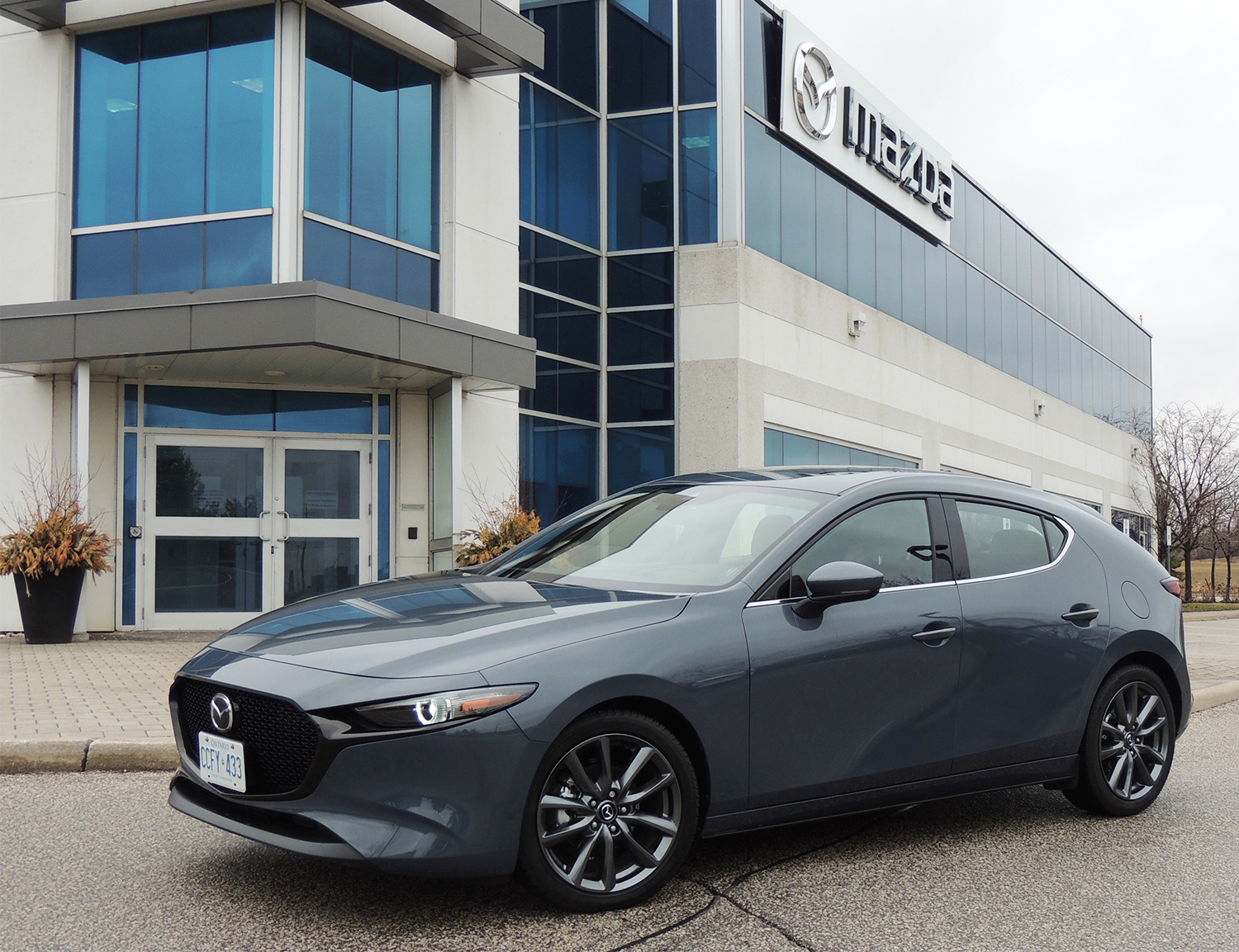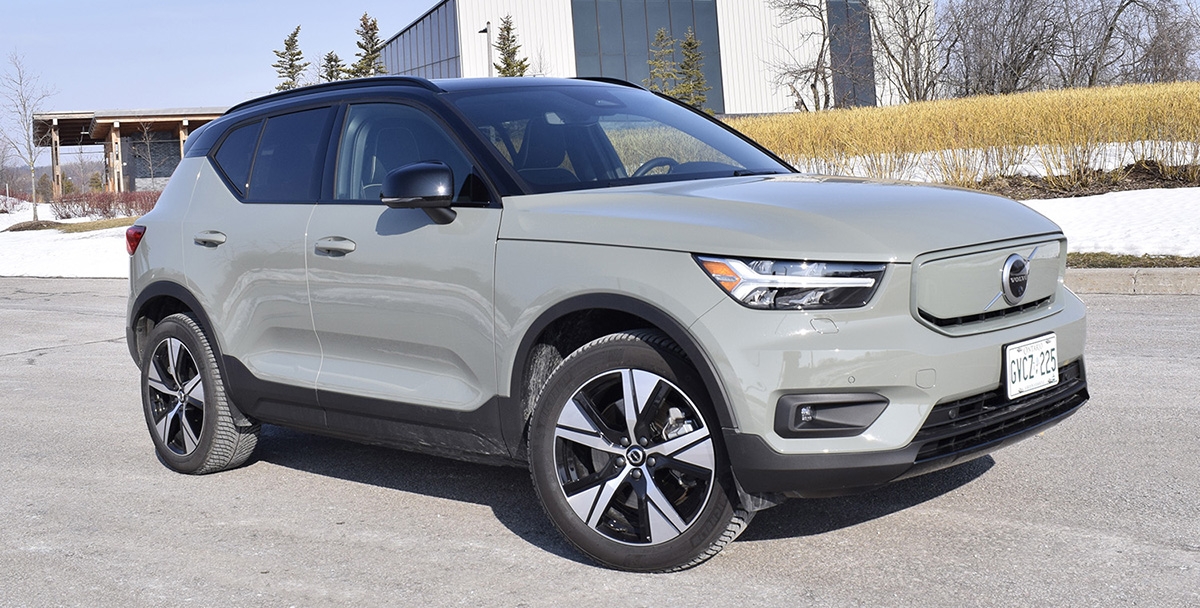
Mazda continues to refine its top-selling vehicle
Back in ’01, I had a Mazda Protégé. It was one of my faves that year among entry-level subcompacts, having plenty of pep, sharpish styling and a decent interior that seemed a step up from entry level.
Then along came the Mazda3. It instantly made my car look frumpy, and since its launch in 2003, it has continued to grow in size, style and sophistication. Not to mention sales, making it the brand’s top-selling vehicle, now at more than six million sold worldwide.

(Photo Credit: Neil Moore)
I’d credit much of this success to the “Kodo” design language. Mazda3 doesn’t look like a “go-to” ride for those short on cash or just entering the workforce. And the 2019 model, which debuted at the 2018 Los Angeles Auto Show, raises the styling bar even higher.
Mazda3 comes in two models: sedan and hatchback (aka the ‘Sport’) with three trim levels: GX, GS, and GT. The four-door sedan starts at $18K for the base front-driver, with 2.0L four cylinder engine and six-speed manual gearbox. It tops out with the $30,400 GT, which includes a more potent 2.5L engine with six-speed automatic and AWD.
The five-door Sport hatchback starts a few grand north at $21,300, but it comes with more gear, and I would suggest it’s the more fetching of the two. Which is saying a lot as both models wear a low, coupe-like silhouette with a long, tapered front bonnet that ends in a black grille – flanked by narrowed, and slightly sinister, LED headlamps.
My tester for the week was the fully-dressed Sport GT. Adding to its ‘cool factor’ was the new “polymetal grey” paint job, along with big 18-inch silver alloys, pushed to the corners. With its low, wide stance and chopped rear end (with roof spoiler and dual exhausts), this hatch lived up to its moniker.
It was also surprisingly posh on the inside. Mine wore two-tone red and charcoal, with a double-stitched red faux leather that carries on through the dash and door panels, ending in a pair of brushed aluminum Bose speaker grilles. Seats were wrapped in a matching red perforated leather, and were as supportive as they were attractive.
My regular drive route included an abundance of potholed, spring asphalt, which produced neither squeaks nor rattles in the cabin. Indeed, Mazda has done a good job in minimizing noise, vibration and harshness through better sound absorption that includes a new “two-wall” insulation structure that leaves a gap between body and carpeting on the floor.

(Photo Credit: Neil Moore)
Attention was also paid to the audio system, for instance, positioning woofers within the front cowl instead of on the door panels, where they’d cause door pocket contents to vibrate and buzz.
As you’d expect in a vehicle with a tapered cabin and fashionably low roofline, back seats are a bit snug. That being said, if you’re under six feet tall, you’ll likely find enough head and leg room.
PR departments are known for providing journalists with the top-drawer vehicles, and I haven’t yet driven the entry model. But you needn’t spend large for a well-equipped Mazda3. Even the GX has a surprisingly long list of standard content.
Both sedan and hatch get an 8.8-inch wide center display as part of the Mazda Connect infotainment system. Its main control knob and buttons are just ahead of the armrest, looking after most vehicle functions, and making for a clean centre stack.
Also standard are an eight-speaker audio system, seven-inch TFT reconfigurable gauge cluster, LED headlights and taillights, Bluetooth, remote keyless entry, push-button start, electronic parking brake, rearview camera, power windows and more.
That’s about it for the sedan, but the higher-priced entry hatchback also includes an essential – air conditioning – along with (thankfully) 16-inch alloys instead of steel wheels with wheel covers, heated seats, power side mirrors with integrated turn signals, and cruise control. All that plus a few more “i-Activsense” safety goodies like blind spot warning and rear cross traffic alert.
Both are powered by a Skyactiv-G 2.0- litre engine that produces 155 horsepower and 150 lb/ft of torque, mated to a six-speed manual transmission. A six-speed automatic is available for another $1,300.
Bottom line: at the entry level, the GX sedan appears to be more of a fleet product; less so for the hatchback, which will be the focus of this review going forward.
Upgrade to the GS hatchback, and you get more goodies like auto headlights, rain-sensing wipers, automatic climate control, heated steering wheel, and a few driver aids: radar cruise control, pedestrian detection, lane departure warning and assist, and driver attention alert.
Thankfully, climate control is still managed by dials and buttons (rather than fiddling with controllers, menus and submenus). Ditto for the three-position heated seats, and heated steering wheel – a feature I’ve grown to appreciate on cold mornings.
Infotainment adjustments, on the other hand, are selected via the widescreen display. It’s reasonably intuitive, and is supported by steering wheel controls that help minimize distraction. Audio volume still gets an old-school knob.

(Photo Credit: Neil Moore)
GS models are powered by a Skyactiv-G 2.5-litre that delivers a more potent 186 hp and 186 lb/ft of torque – along with cylinder deactivation to aid fuel economy. Its consumption figures are close to the 2.0-litre, and at 9.2/9.0 L/100 km in the city (manual/auto) and 6.6/6.8 on the highway (manual/auto), this powertrain is thrifty. I logged an average of 8.5L/100 km in mostly urban driving.
All-wheel-drive is available for $1,700. It’s a consideration for those who desire more winter stability and prefer the lower stance of a car, as opposed to a crossover like the CX-3
My Sport GT ($28,400) wasn’t equipped with i-Active AWD, but included nearly everything from the Mazda parts bin, like automatic levelling adaptive front headlights, power moonroof, and 12-speaker Bose audio system, not to mention some Premium Package upgrades like leather seats (with 10-way power adjust and memory for the driver), navigation, rear parking sensors, and heads-up display with traffic sign recognition. Add $200 for the Polymetal Gray paint job.
HUDs were once the domain of higher-priced rides, but I’ve always liked them. Rather than glancing down for the speed limit, it’s in your line of sight, along with the posted speed limit – which keeps your eyes on the road. Drivers shouldn’t have to agonize over this, but in an environment of speed traps and impending photo radar, one can’t be too careful.
Nonetheless, the GT was a pleasure to drive, and having a six-speed manual added to it. Gearing of the 2.5-litre seemed a bit tall, but having a clutch with near-perfect take-up made it a joy rowing through the gears. My only gripe was that it redlines at 6,500 rpm.
The automaker is known in most segments for cut-above handling, and the Mazda3 does not disappoint. Its independent front suspension (MacPherson struts/stabilizer) and torsion beam rear, is taut in the corners, but at the same time, is forgiving on rough roads.
Add in G-Vectoring Control, which uses the brakes to, very subtly, increase the load on the front tires, and you feel more grip in the turns. In particular, on slippery surfaces.

(Photo Credit: Neil Moore)
Indeed Mazda3 has grown up, and depending on trim level, delivers an almost premium experience for the price. As its competition continues to build better Elantras, Civics, Corollas – and the like – so too is Mazda refining its volume-selling compact that just keeps getting better.
SNAPSHOT: 2019 Mazda3 Sport GT
BODY STYLE: 5-door hatchback
ENGINE: Skyactiv-G 2.5-litre four cylinder with cylinder deactivation (186 hp, 186 lb/ft of torque)
TRANSMISSION: 6-speed manual
DRIVE: Front Wheel Drive (FWD)
FUEL ECONOMY: 9.2/6.6 litres/100km (city/hwy)
CARGO: 569 litres, 1,334 litres with rear seats folded
PRICING: GX starts at $21,300, GS starts at $24,000. GT manual $28,400 with Premium Package (included) – add Polymetal Grey Metallic paint ($200). Freight and taxes extra.
WEBSITE: www.mazda.ca









